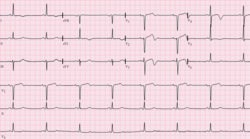Wellens' syndrome
Editor-In-Chief: Prab R Tumpati, MD
Obesity, Sleep & Internal medicine
Founder, WikiMD Wellnesspedia &
W8MD medical weight loss NYC and sleep center NYC
| Wellens' syndrome | |
|---|---|

| |
| Synonyms | LAD coronary T-wave syndrome |
| Pronounce | |
| Specialty | Cardiology |
| Symptoms | Chest pain, T-wave inversion in ECG |
| Complications | Myocardial infarction |
| Onset | |
| Duration | |
| Types | Type A, Type B |
| Causes | Coronary artery disease |
| Risks | |
| Diagnosis | Electrocardiogram, Cardiac catheterization |
| Differential diagnosis | |
| Prevention | |
| Treatment | Percutaneous coronary intervention, Coronary artery bypass surgery |
| Medication | |
| Prognosis | High risk of myocardial infarction if untreated |
| Frequency | |
| Deaths | |
Wellens' syndrome is a pattern of ECG changes associated with critical stenosis of the left anterior descending coronary artery, which can progress to an extensive anterior wall myocardial infarction if not recognized and treated appropriately. It is named after Hein J.J. Wellens, a Dutch cardiologist who first described the syndrome in 1982.
Clinical Presentation
Patients with Wellens' syndrome typically present with a history of angina, often with a recent increase in frequency or severity. The pain is usually described as a heavy or squeezing sensation in the chest, often radiating to the left arm or jaw. On examination, the patient may appear anxious and sweaty, but is often comfortable at rest.
Diagnosis
The diagnosis of Wellens' syndrome is made on the basis of the characteristic ECG changes, which include deep, symmetric T wave inversions in the anterior leads (V1-V4). These changes are typically present during pain-free periods and may be transient, reverting to normal between episodes of pain. Other diagnostic criteria include the absence of significant ST segment elevation and the absence of pathologic Q waves.
Treatment
The treatment of Wellens' syndrome involves urgent coronary angiography to identify the site of the critical stenosis, followed by revascularization, usually by means of percutaneous coronary intervention (PCI). Medical management with antiplatelet therapy, beta blockers, and statins is also important.
Prognosis
The prognosis of Wellens' syndrome is poor if left untreated, with a high risk of progression to extensive anterior wall myocardial infarction. However, with early recognition and appropriate treatment, the prognosis can be significantly improved.
See Also
Transform your life with W8MD's budget GLP-1 injections from $125.
W8MD offers a medical weight loss program to lose weight in Philadelphia. Our physician-supervised medical weight loss provides:
- Most insurances accepted or discounted self-pay rates. We will obtain insurance prior authorizations if needed.
- Generic GLP1 weight loss injections from $125 for the starting dose.
- Also offer prescription weight loss medications including Phentermine, Qsymia, Diethylpropion, Contrave etc.
NYC weight loss doctor appointments
Start your NYC weight loss journey today at our NYC medical weight loss and Philadelphia medical weight loss clinics.
- Call 718-946-5500 to lose weight in NYC or for medical weight loss in Philadelphia 215-676-2334.
- Tags:NYC medical weight loss, Philadelphia lose weight Zepbound NYC, Budget GLP1 weight loss injections, Wegovy Philadelphia, Wegovy NYC, Philadelphia medical weight loss, Brookly weight loss and Wegovy NYC
|
WikiMD's Wellness Encyclopedia |
| Let Food Be Thy Medicine Medicine Thy Food - Hippocrates |
Medical Disclaimer: WikiMD is not a substitute for professional medical advice. The information on WikiMD is provided as an information resource only, may be incorrect, outdated or misleading, and is not to be used or relied on for any diagnostic or treatment purposes. Please consult your health care provider before making any healthcare decisions or for guidance about a specific medical condition. WikiMD expressly disclaims responsibility, and shall have no liability, for any damages, loss, injury, or liability whatsoever suffered as a result of your reliance on the information contained in this site. By visiting this site you agree to the foregoing terms and conditions, which may from time to time be changed or supplemented by WikiMD. If you do not agree to the foregoing terms and conditions, you should not enter or use this site. See full disclaimer.
Credits:Most images are courtesy of Wikimedia commons, and templates, categories Wikipedia, licensed under CC BY SA or similar.
Contributors: Prab R. Tumpati, MD




